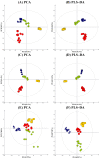Integrated Metabolomics and Volatolomics for Comparative Evaluation of Fermented Soy Products
- PMID: 34828797
- PMCID: PMC8624193
- DOI: 10.3390/foods10112516
Integrated Metabolomics and Volatolomics for Comparative Evaluation of Fermented Soy Products
Abstract
Though varying metabolomes are believed to influence distinctive characteristics of different soy foods, an in-depth, comprehensive analysis of both soluble and volatile metabolites is largely unreported. The metabolite profiles of different soy products, including cheonggukjang, meju, doenjang, and raw soybean, were characterized using LC-MS (liquid chromatography-mass spectrometry), GC-MS (gas chromatography-mass spectrometry), and headspace solid-phase microextraction (HS-SPME) GC-MS. Principal component analysis (PCA) showed that the datasets for the cheonggukjang, meju, and doenjang extracts were distinguished from the non-fermented soybean across PC1, while those for cheonggukjang and doenjang were separated across PC2. Volatile organic compound (VOC) profiles were clearly distinct among doenjang and soybean, cheonggukjang, and meju samples. Notably, the relative contents of the isoflavone glycosides and DDMP (2,3-dihydro-2,5-dihydroxy-6-methyl-4H-pyran-4-one) conjugated soyasaponins were higher in soybean and cheonggukjang, compared to doenjang, while the isoflavone aglycones, non-DDMP conjugated soyasaponins, and amino acids were significantly higher in doenjang. Most VOCs, including the sulfur containing compounds aldehydes, esters, and furans, were relatively abundant in doenjang. However, pyrazines, 3-methylbutanoic acid, maltol, and methoxyphenol were higher in cheonggukjang, which contributed to the characteristic aroma of soy foods. We believe that this study provides the fundamental insights on soy food metabolomes, which determine their nutritional, functional, organoleptic, and aroma characteristics.
Keywords: fermented soy product; metabolic pathway; metabolomics; volatolomics.
Conflict of interest statement
The authors declare no conflict of interest.
Figures


 ; soy, -
; soy, -  ; cheonggukjang,
; cheonggukjang,  ; meju,
; meju,  ; doenjang.
; doenjang.


Similar articles
-
Comprehensive Metabolite Profiling and Microbial Communities of Doenjang (Fermented Soy Paste) and Ganjang (Fermented Soy Sauce): A Comparative Study.Foods. 2021 Mar 18;10(3):641. doi: 10.3390/foods10030641. Foods. 2021. PMID: 33803678 Free PMC article.
-
Comparison of fermented soybean paste (Doenjang) prepared by different methods based on profiling of volatile compounds.J Food Sci. 2011 Apr;76(3):C368-79. doi: 10.1111/j.1750-3841.2011.02068.x. Epub 2011 Mar 16. J Food Sci. 2011. PMID: 21535802
-
Metabolomic-Based Comparison of Traditional and Industrial Doenjang Samples with Antioxidative Activities.Foods. 2021 Jun 15;10(6):1377. doi: 10.3390/foods10061377. Foods. 2021. PMID: 34203585 Free PMC article.
-
Fermented Soy Products and Their Potential Health Benefits: A Review.Microorganisms. 2022 Aug 9;10(8):1606. doi: 10.3390/microorganisms10081606. Microorganisms. 2022. PMID: 36014024 Free PMC article. Review.
-
Fermented Soy Products: Beneficial Potential in Neurodegenerative Diseases.Foods. 2021 Mar 18;10(3):636. doi: 10.3390/foods10030636. Foods. 2021. PMID: 33803607 Free PMC article. Review.
Cited by
-
Integrated omic analysis of a new flavor yeast strain in fermented rice milk.FEMS Yeast Res. 2025 Jan 30;25:foaf017. doi: 10.1093/femsyr/foaf017. FEMS Yeast Res. 2025. PMID: 40153366 Free PMC article.
-
Comparison of microbial diversity and metabolites on household and commercial doenjang.Food Chem X. 2023 Dec 25;21:101101. doi: 10.1016/j.fochx.2023.101101. eCollection 2024 Mar 30. Food Chem X. 2023. PMID: 38268844 Free PMC article.
-
Comprehensive Metabolite Profiling of Four Different Beans Fermented by Aspergillus oryzae.Molecules. 2022 Nov 16;27(22):7917. doi: 10.3390/molecules27227917. Molecules. 2022. PMID: 36432017 Free PMC article.
-
Characterization of Key Aroma Compounds of Soy Sauce-like Aroma Produced in Ferment of Soybeans by Bacillus subtilis BJ3-2.Foods. 2024 Aug 28;13(17):2731. doi: 10.3390/foods13172731. Foods. 2024. PMID: 39272497 Free PMC article.
-
Foodomics: Current and Future Perspectives in Food Analysis.Foods. 2022 Apr 26;11(9):1238. doi: 10.3390/foods11091238. Foods. 2022. PMID: 35563961 Free PMC article.
References
-
- Feron G., Bonnarme P., Durand A. Prospects for the Microbial Production of Food Flavours. Trends Food Sci. Technol. 1996;7:285–293. doi: 10.1016/0924-2244(96)10032-7. - DOI
-
- Blandino A., Al-Aseeri M.E., Pandiella S.S., Cantero D., Webb C. Cereal-Based Fermented Foods and Beverages. Food Res. Int. 2003;36:527–543. doi: 10.1016/S0963-9969(03)00009-7. - DOI
-
- Egounlety M., Aworh O.C. Effect of Soaking, Dehulling, Cooking and Fermentation with Rhizopus Oligosporus on the Oligosaccharides, Trypsin Inhibitor, Phytic Acid and Tannins of Soybean (Glycine Max Merr.), Cowpea (Vigna Unguiculata L. Walp) and Groundbean (Macrotyloma Geocarpa Harms) J. Food Eng. 2003;56:249–254. doi: 10.1016/S0260-8774(02)00262-5. - DOI
-
- Singh D., Lee S., Lee C.H. Metabolomics for Empirical Delineation of the Traditional Korean Fermented Foods and Beverages. Trends Food Sci. Technol. 2017;61:103–115. doi: 10.1016/j.tifs.2017.01.001. - DOI
-
- Shin D., Jeong D. Korean Traditional Fermented Soybean Products: Jang. J. Ethn. Foods. 2015;2:2–7. doi: 10.1016/j.jef.2015.02.002. - DOI
Grants and funding
LinkOut - more resources
Full Text Sources
Research Materials
Miscellaneous

